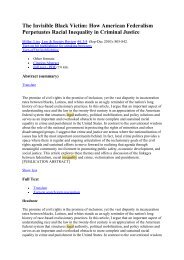Ski – resort and regional development: profile of visitors ... - E-Journal
Ski – resort and regional development: profile of visitors ... - E-Journal
Ski – resort and regional development: profile of visitors ... - E-Journal
You also want an ePaper? Increase the reach of your titles
YUMPU automatically turns print PDFs into web optimized ePapers that Google loves.
82<br />
Onome Daniel Awaritefe<br />
were also found in earlier studies by Afolabi (1993), <strong>and</strong> Fekeye <strong>and</strong> Crompton (1977) to<br />
have considerably influenced destination patronage by tourists. In contrast, more recent<br />
research (Moscardo, 2000; Lubbe, 1999; <strong>and</strong> Zapalska, et al 2004) tended more to favour<br />
cultural or man-made components as destination determinants <strong>of</strong> tourists’ choices <strong>and</strong> dem<strong>and</strong><br />
patterns.<br />
It is in light <strong>of</strong> such empirical contradictions that Knudson (1998) argued that majority <strong>of</strong><br />
existing studies on determinants <strong>of</strong> destination product dem<strong>and</strong> appear inconclusive due to<br />
certain reasons as flaws in manner <strong>of</strong> variable selection, data collection <strong>and</strong> measurements.<br />
Nevertheless, as Knudson further observes, many scholars still believe that some relationships<br />
exist between tourist’s product dem<strong>and</strong>s <strong>and</strong> demographic, social, cultural <strong>and</strong> environmental<br />
factors, though some empirical evidence points to the contrary. In line with Knudson, Lea<br />
(1999) suggest that further research are therefore required to make reliable statements on these<br />
suspect determinants <strong>of</strong> tourism destination product dem<strong>and</strong>. It is in the context <strong>of</strong> these<br />
contradictions <strong>and</strong> flaws in the literature, <strong>and</strong> need for further verification <strong>of</strong> the belief that<br />
demographic, social, culture/nationality <strong>of</strong> tourist <strong>and</strong> destination quality determine tourist<br />
product dem<strong>and</strong> that this study is designed, using a Third world tropical country, Nigeria, as<br />
environment <strong>of</strong> study.<br />
CONTEXT OF STUDY AREA<br />
The study area, Nigeria, is located in West Africa, between latitudes 5°N <strong>and</strong> 14°N, <strong>and</strong><br />
longitudes 3°E <strong>and</strong> 15°E.. With a population <strong>of</strong> about 120 million people, Nigeria occupies<br />
an area <strong>of</strong> approximately 913,768 Sq. Kms (Awaritefe, 2000). Attractions to tourists in Nigeria<br />
are both natural <strong>and</strong> cultural features. The primary natural attractions for tourism include<br />
outst<strong>and</strong>ing scenic l<strong>and</strong>form areas such as beaches, rivers <strong>and</strong> inselberges, <strong>and</strong> the rainforest<br />
<strong>and</strong> savannah vegetation, which provides natural habitat for a wide variety <strong>of</strong> wildlife/game.<br />
Nigeria is also endowed with good climate, all year sunshine, <strong>and</strong> good location along the<br />
coast <strong>of</strong> the Atlantic Ocean, all <strong>of</strong> which encouraged the <strong>development</strong> <strong>of</strong> numerous good<br />
beaches, especially around Lagos. The unique cultural attractions in Nigeria include a chain<br />
<strong>of</strong> national museums, ancient slave sites, <strong>and</strong> ancient palaces <strong>and</strong> shrines. It is from these vast<br />
<strong>and</strong> diverse tourism resources that seven tourism destinations were selected for detailed study<br />
<strong>of</strong> tourists <strong>and</strong> their product dem<strong>and</strong> in Nigeria (See Figure 1). The seven centers selected for<br />
study include Yankari Park, Kainji Lake Park, <strong>and</strong> Obudu Ranch; these represent the<br />
nature/ecotourism destinations in Nigeria. Three destinations - Jos, Benin City <strong>and</strong> Badagry<br />
Beach were also selected to represent the urban/cultural <strong>and</strong> historic tourism destinations in<br />
the country. It is from the public museums, cultural centres <strong>and</strong> parks in Benin City, Jos <strong>and</strong><br />
Badagry beach areas that tourists were sampled. Additionally, Abraka River Resort was<br />
selected to represent hotel <strong>resort</strong>s. The seven destinations were also selected such that one<br />
was picked from each <strong>of</strong> the six geo-political zones in Nigeria; though two destinations were<br />
selected from the South-West Zone because <strong>of</strong> the larger concentration <strong>of</strong> tourism destinations<br />
in that zone.<br />
Tourism Today - Fall 2007 - Full Paper














